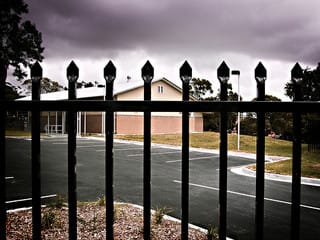First, Louisiana’s top-rated school district opted to participate in the state’s new school voucher program. Then, less than two weeks later, it opted out.
 We are left with a community that has chosen to erect a fence around its public schools. Photo by Martin Magdalene. |
Why the quick reversal? Once Zachary schools Superintendent Warren Drake announced the district’s intent to “make a difference” for children coming from C-, D-, or F-rated schools, his community told him to back off.
In a written statement, Drake scrapped his original plan with a declaration that illustrates the challenges school choice advocates face even after their hard-won legislative victories:
We recognize the sacrifices many of our own families make to provide their students with a first-rate education and appreciate the community’s continued financial support of our district.
As with many private school choice plans, Louisiana’s voucher allows students from poor-performing public schools to switch to high-performing public schools. And the best-performing public schools in the Pelican State are found in Zachary.
But, as with many plans that allow cross-district school choice, sometimes those who make “sacrifices” for the best want to keep their investment exclusive.
Michigan Gov. Rick Snyder learned that lesson after he proposed making the voluntary cross-district choice policy in his state mandatory. Most of the districts in Michigan that refuse to allow other students to enter their boundaries are the wealthier suburban school systems that border Detroit. The Grosse Pointe school district, to name one, went so far as to pass a resolution fighting Snyder’s effort that sought to preserve the “personal sacrifices” of its citizens who opted to invest “in premium housing stock.” The governor’s plan later died in a legislative committee.
What’s surprising about Zachary’s resistance is that it has shown greater outreach to disadvantaged students in the past. As Drake reminded his school board, Zachary Community Schools took in 300 students who were displaced from their homes in the aftermath of Hurricane Katrina in 2005.
Sometimes those who make “sacrifices” for the best want to keep their investment exclusive.
But in the days following last week’s board meeting, parents and others in Zachary appealed to Drake and school board members to reconsider their decision. First, there was confusion about the cost, but that fog cleared after the state explained that a student’s full public funding—averaging $8,500—would accompany the child. Then Drake justified the reversal by noting that teachers would be burdened next year with a new evaluation system and didn’t need the stress of more students, but he told board members previously that the voucher would add only one new student in each kindergarten and first-grade class.
So we are left with a community that has chosen to erect a fence around its public schools.
The Black Alliance for Educational Options has since urged the school system to reverse its reversal, but its plea is too little, too late. As Zachary and Grosse Pointe have shown, advocates like BAEO and lawmakers who champion school choice have to take their fight outside the statehouse and into the communities that are supposed to provide better options for students who have so few. If they can’t convince better-performing schools to open their doors to low-income, low-achieving children, then their legislative victories will be short-lived.
Correction: A previous version of this post incorrectly stated that Zachary changed its position after two days, not two weeks.
